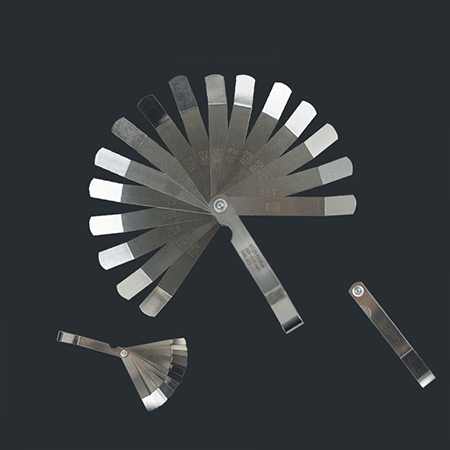The angled feeler gauge is a precision tool designed to measure gaps and clearances in hard-to-reach or angled spaces. This metric feeler gauge is made from high-quality spring alloy metal, which offers both durability and flexibility, allowing it to withstand regular use without bending or breaking.

The metric feeler gauge is made of high-quality spring alloy metal
- The feeler gauge is made from premium spring alloy steel, ensuring excellent durability, flexibility, and resilience. This material is designed to withstand repetitive bending without losing its shape, providing consistent and reliable performance over time.
- The high-quality metal is resistant to corrosion, ensuring the longevity of the tool even in harsh environments, and maintaining smooth operation without rust or degradation.
- The alloy steel construction offers high precision, ensuring that each gauge is thin and uniform in thickness, allowing for accurate gap measurements in precision mechanical work.

Angled feeler gauge features
- Metal fixing nut: Each feeler gauge tail is fixed by a metal nut, which is easy to use and not easy to fall off.
- High-quality steel forged blade: spring steel body plus stainless steel shell, overall heat treatment.
- Clear steel stamp model identification: The surface of the feeler gauge shell clearly indicates the product model, specifications and other information, which is convenient for quick identification when using.
Dimension

Applications
SISCO feeler gauge is a precision tool designed to measure the clearance or gap between two surfaces. It’s widely used in automotive repair to check valve and spark plug gaps, in machinery calibration for precise tolerance settings, and in electronics assembly to ensure proper spacing between components, and in industrial equipment maintenance to verify part alignment and prevent excessive wear.

Machinery Calibration

Electronics Assembly

Equipment Maintenance

Automotive Repair
| Model | SISCO-FG-16BL |
| Measuring Range | 0.127-0.508mm |
| Number of Blades | 16 |
| Blade Length | 100mm |
| Blade Shape | Long |
| Material | Alloy steel |
| Weight | 65g |
Q1: What is a feeler gauge?
A1: A feeler gauge is a precision tool used to measure the gap or clearance between two surfaces. It consists of a set of thin, flat blades of various thicknesses, each marked with its corresponding measurement. These blades can be inserted into the gap to determine its size. Feeler gauges are commonly used in mechanical, automotive, and industrial applications to check the spacing between parts such as engine valves, spark plugs, or machinery components, ensuring they meet specific tolerance requirements.
Q2: Can I use multiple blades at once?
A2: Yes, you can use multiple blades from a feeler gauge set at once. This is often done when the gap you need to measure falls between the thicknesses of two or more individual blades. By stacking multiple blades together, you can achieve the desired thickness and accurately measure the gap.
For example, if the gap is 0.25 mm and there is no single blade that matches this exactly, you could use a 0.15 mm blade and a 0.10 mm blade together to measure the gap. Just make sure the stacked blades fit snugly and fully into the gap for an accurate measurement.
Q3: Can feeler gauges be used for all types of measurements?
A3: Feeler gauges are specifically designed for measuring narrow gaps or clearances between two surfaces, so they are not suitable for all types of measurements. They are ideal for tasks such as checking the clearance in engine parts, machinery, or measuring small gaps in assemblies. However, feeler gauges are not suitable for measuring large gaps, thicknesses of solid materials, or external dimensions like the diameter of a cylinder.
For measurements outside their intended purpose, such as material thickness or larger distances, other tools like calipers, micrometers, or thickness gauges are more appropriate and accurate.
Tips: Is the angled feeler gauge suitable for heavy-duty use?
Yes, the angled feeler gauge is suitable for heavy-duty use, especially when made from high-quality spring alloy metal. The alloy construction provides excellent durability, flexibility, and resilience, allowing it to withstand mechanical stresses and repeated use without warping or losing accuracy. This makes it ideal for industrial, automotive, and engineering applications that require reliable, long-lasting tools.
Its ability to handle high mechanical loads, combined with its corrosion-resistant properties, ensures it performs well even in harsh environments or demanding tasks. However, it's important to avoid excessive bending or misuse, which could compromise the tool's performance.
Thank you for buying industrial test and measurement equipment on SISCO.com, all products sold by SISCO and the partner cover a 12 months warranty, effective from the date of receiving the products.
What is covered?
SISCO is responsible for providing free spare parts, and free technical support to assist the customer to repair the defective products until the problem is solved.
What is not covered?
- Product purchased from anyone other than a SISCO store or a SISCO authorized reseller.
- Expendable parts.
- Routine cleaning or normal cosmetic and mechanical wear.
- Damage from misuse, abuse or neglect.
- Damage from use of parts other than SISCO approved.
- Damage from use outside the product’s usage or storage parameters.
- Damage from use of parts not sold by SISCO.
- Damage from modification or incorporation into other products.
- Damage from repair or replacement of warranted parts by a service provider other than a SISCO authorized service provider.
- Damage caused by the application environment not meeting the product usage requirements and the failure to perform preventive maintenance.

